We attacked the next leg with dreams of grandeur. Just like Sossusvlei had been the apotheosis of our 2009 Namib trip, Southern Africa’s highest mountain pass was going to be something to write home about.
Located in the Drakensberg mountain range, on the 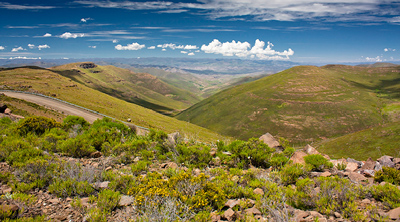 easternmost flank of Lesotho, the Sani Pass leads from Basotho Highlands to South Africa’s KwaZulu Natal province, in a long climb and a hairy descent that drops pretty much straight down from one of the highest roads in Africa.
easternmost flank of Lesotho, the Sani Pass leads from Basotho Highlands to South Africa’s KwaZulu Natal province, in a long climb and a hairy descent that drops pretty much straight down from one of the highest roads in Africa.
That road, as most in the area, is made of dirt and gravel. In fact, dirt, gravel and boulders, as we would soon find out. A few hundred kilometers long, the approach climbs irregularly all the way from the northwestern border of Lesotho through the Maluti Mountains and into the Drakensberg, then flattens out for a while on a ghostly high plateau inhabited only by solitary herders and then, suddenly, plunges down towards South Africa, in a tight zigzagging series of hairpin turns only negotiable by four-wheel drive vehicles.
Strangely, the Basotho border post is perched at the top of the pass and the South African one at its bottom, some ten kilometers below. South African authorities strictly 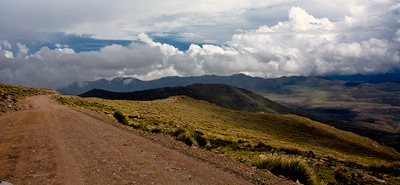 prohibit access to unsuited vehicles – in other words if you don’t drive a real 4×4, you don’t go up. The road ascends (or descends, depending on the direction of travel) from 1,586 meters at the Sani Pass Hotel, South Africa, to 2,873 meters at the very top, twenty-two kilometers all in all – or in the steepest section, about 1,000 vertical meters from border post to border post in a mere nine kilometers.
prohibit access to unsuited vehicles – in other words if you don’t drive a real 4×4, you don’t go up. The road ascends (or descends, depending on the direction of travel) from 1,586 meters at the Sani Pass Hotel, South Africa, to 2,873 meters at the very top, twenty-two kilometers all in all – or in the steepest section, about 1,000 vertical meters from border post to border post in a mere nine kilometers.
A couple of kilometers from the top of the pass rises the highest peak in Southern Africa, Thabane Ntlenyana, 3,482 meters.
As one can imagine with such staggering statistics, the Sani Pass is associated with many a scary story and we had heard them all, from automobile carcasses lying at the bottom of the valley after failed attempts, to ice and snow closing the road in the deep of winter.
Our itinerary was going to take us across Lesotho and into South Africa – hence down the pass, the easiest direction of travel, so we didn’t worry too much. Coming from Golden Gate, we again crossed at Caledonspoort. There were a few other high passes to be scaled along the way and one of them, the Moteng Pass, climbed to Afriski – highest ski resort in all of Africa below the Tropic of Cancer. Well, that’s not such a big deal since there are only… two.
Now used to the reality of pedestrian traffic on narrow roads, we took our time and by early afternoon, we were becoming acquainted with the Drakensberg slopes. Then we suddenly came upon a tight open bend in the dirt road. Workers up ahead waved and yelled at us to stop. I 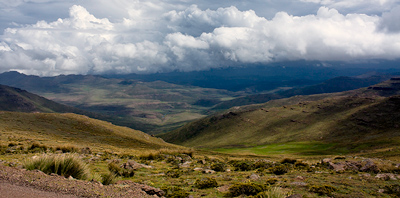 stepped on the brakes and pulled over. There was a problem.
stepped on the brakes and pulled over. There was a problem.
A few pick-ups were parked in the way and the scene showed surprising human activity, an ephemeral oasis of life after hours of quiet nothingness.
Right above us to the left, where the road continued its steep ascent to a neck, a large truck was stopped and people had gathered around it. Their body language was easily deciphered: they moved and talked according to the international code of mechanical trouble; the truck had broken down, they were trying to fix it. It was stopped right in the middle of a steep narrow section, there was no way to drive around it. However little traffic arrived in both direction, it would be held up.
Marie and I sat back for a while, watching the scene and trying to gauge the possibility of a positive outcome to this delay. We were on the only road leading to the Sani Pass and South Africa. If it remained blocked, we’d have to backtrack for hours in order to find another way out of Lesotho.
Light rain began to fall. Donning my raincoat, I ventured out and walked up to the scene. A road worker was talking to another crouching inside the truck’s high cabin. He turned around and answered my question grimly – in English thankfully. “It’s the clutch. Broken. We can’t even back down the slope to the bottom of the curve.” “Does he have any hopes of fixing this?” I asked waving at the guy in the truck who was handling a very large wrench. “Maybe,” the man said.
I returned to the Landcruiser and spilled the news. The Sani Pass 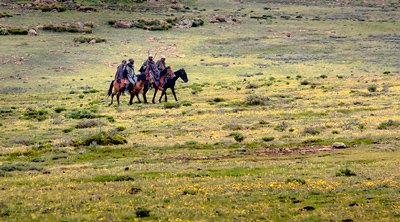 had become optional. We tried to remain optimistic but evaluated our options. We had already been stuck there for some forty-five minutes. We might have to escape backwards.
had become optional. We tried to remain optimistic but evaluated our options. We had already been stuck there for some forty-five minutes. We might have to escape backwards.
Suddenly, there was movement above us. I looked up. The truck had crept back a few inches. Then it happened again. Everybody got agitated and men began shouting at each other. Someone walked to the back of the truck to guide while the improvised mechanic was sitting behind the wheel. Freeing the clutch, he managed to start the engine and reversed slowly all the way to the widest section below. Traffic was free to go. The few pick-ups that had been held up all went by screaming in both directions and I let them have at it, knowing full well they would be driving twice our speed. We could now resume our quest.
Our maps had proven to be a little unreliable. Distances were variable and small Basotho towns randomly vanished and changed names from one edition to the next. When we suddenly found ourselves at the top of a long climb and a sign announced an altitude I’ve now forgotten, we thought we had reached the infamous Sani Pass. But a long plateau stretched far into the distance to a new mountain range. Something was off. The pass was supposed to drop straight down the slopes of the Drakensberg into relatively low terrain.
After a thorough analysis of all maps, we figured that not only had we 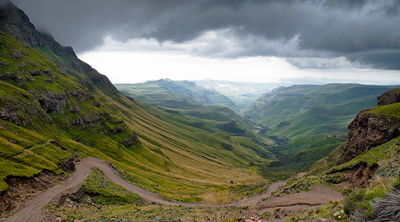 not arrived, there was a long way to go. We drove on as the sky darkened and clouds descended to meet the high desolate landscape. Solitary herders were riding their horses, slipping in and out of the mist, ghostly figures in a world of remote and harsh beauty. The mountain air was very chilly and as we cruised at altitudes between 2500 and 3000 meters, we had to reflect on how far in our conscience the other Africa had receded. We were slicing our way through the continent’s roof, our imagination flirting with shapes and legends in the descending fog.
not arrived, there was a long way to go. We drove on as the sky darkened and clouds descended to meet the high desolate landscape. Solitary herders were riding their horses, slipping in and out of the mist, ghostly figures in a world of remote and harsh beauty. The mountain air was very chilly and as we cruised at altitudes between 2500 and 3000 meters, we had to reflect on how far in our conscience the other Africa had receded. We were slicing our way through the continent’s roof, our imagination flirting with shapes and legends in the descending fog.
Eventually, we came upon a few Basotho houses and a longer shack on the right side of the road. There was no gate and no one in sight, but we knew we had arrived at the first border crossing. We were about to leave Lesotho. Ahead of us and below, the road would plunge towards the South African post, some ten kilometers further down. We had found the actual Sani Pass.
Marie parked the Landcruiser and we walked over to the low prefab building with our passports, glancing around us curiously. This was one of the most isolated border crossing I’d ever seen and the fog made the place Hitchcockesque. We stepped into the outpost and were greeted by relative warmth. Two officers were looking at a laptop screen, probably watching a movie. A fire burned at the end of the room in a small fire-place. It was like entering a movie scene.
Formalities were expedited and we went back out into the cold. A few 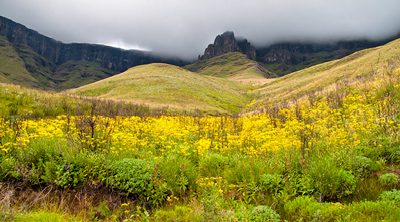 hundred meters away, we could see another building that was probably the Sani Top Chalet, a backpackers’ hotel hailed on the internet as featuring the highest pub in Africa. We didn’t even see a road leading to it. Our attention was focused on the path down.
hundred meters away, we could see another building that was probably the Sani Top Chalet, a backpackers’ hotel hailed on the internet as featuring the highest pub in Africa. We didn’t even see a road leading to it. Our attention was focused on the path down.
Marie got behind the wheel and we slowly headed into the vertical no man’s land that separates the two countries. It was rather dramatic. With the clouds closing down on us and limiting visibility to a few hundred feet, we had no view and could only imagine the drop-off.
Immediately, the road seemed to disappear from underneath our wheels and Marie found herself negotiating a series of tight turns with her foot on the brakes, trying to keep our speed slow and the wheels from sliding on the wet rocks that paved the way. She doesn’t like heights and each turn was a torture to her as, to go around, she had to first lead us straight into the cloudy void and turn at the last second.
The road was incredibly bad. Despite the Landcruiser’s high clearance, she was forced to work her way around huge boulders. Soon, she had had enough. “This is crazy. It’s too dangerous,” she said. She wanted out. Out, however, meant up, which was not really an option. We could have gone back to the hotel and waited for the 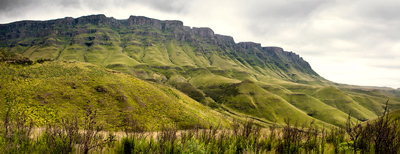 clouds to lift but probably would have had to spend the night. We were committed.
clouds to lift but probably would have had to spend the night. We were committed.
“It’ll be fine,” I said with more bravado than I felt. “I’ll drive us down, you’ve done your part.” I switched the differential to Low, locking the wheels together two by two and slowing us down to a sick turtle’s pace. Down we went.
The road was so steep that in some spots it felt like I was standing on the pedals. I tried to use engine braking as much as I could to keep the brakes from overheating. In the sharpest turns, Marie got out, as much to guide me as to be out of the vehicle as I drove it over and around boulders straight at the precipice. I often had to come a meter from the edge, on slightly slipping wheels, before I could turn back towards the road and prepare for the next curve. She made me unbuckle, anticipating a forced jump out of the car.
I don’t have any pictures of this section of the pass. There was no time. Marie took a few when she was walking down the tight bends. At one point, a horrible 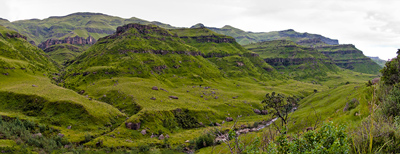 smell drove her to the edge where she was greeted by the gruesome sight of a decomposing horse. The Sani Pass had killed an innocent; but it had that reputation. On the way down, we would see a few car wrecks at the bottom of the ravine, silent reminders that not all who had attempted the pass had succeeded. The internet classified it as dangerous, requiring intermediate to advanced off-road driving skills, depending on the season. I could not even imagine that road in snow and ice.
smell drove her to the edge where she was greeted by the gruesome sight of a decomposing horse. The Sani Pass had killed an innocent; but it had that reputation. On the way down, we would see a few car wrecks at the bottom of the ravine, silent reminders that not all who had attempted the pass had succeeded. The internet classified it as dangerous, requiring intermediate to advanced off-road driving skills, depending on the season. I could not even imagine that road in snow and ice.
Eventually, though, the clouds thinned and light improved. We caught several glimpses of the valley below, and then, just like that, we were out in clear air. We had already left the steepest part above and behind us, and slowly worked our way down. A few vehicles caught up with us. They seemed to be commercial 4×4’s doing the official Sani Pass tour and were just plummeting down the path, their occupants bouncing in all directions as the driver swerved right and left in the bumps.
We reached the South African border post at the same time as two other 4×4’s but managed to get ahead of them while tourists were slowly getting off and stretching. The dirt 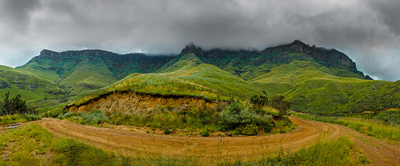 road continued on South African soil, now rather flat and better maintained, and we left the Drakensberg behind us after a last photo stop to look back at the formidable mountains that had finally spat us out like insignificant specs of humanity.
road continued on South African soil, now rather flat and better maintained, and we left the Drakensberg behind us after a last photo stop to look back at the formidable mountains that had finally spat us out like insignificant specs of humanity.
Some three hundred kilometers and ten hours after leaving Golden gate, we arrived in Himeville. We found a small but rather expensive hotel and had dinner there before showering and going to bed. The room was infested with mosquitoes. Marie fell asleep but I was up well into the wee hours. The Sani Pass might have taken its toll but mosquitoes were a much more tangible threat and I fought them bravely.
«Cartwheels Over Lesotho» Series
Want to read the entire series of stories? Start here
Already reading sequentially?
Previous story: Cartwheels over Lesotho, Part 4 – Thy Mountain Kingdom Come
Next story: Cartwheels over Lesotho – Space addendum to Golden Gate
Marie’s recount: Lesotho
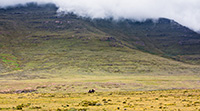
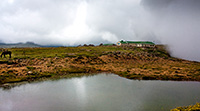
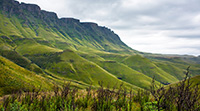
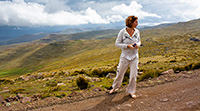
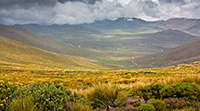
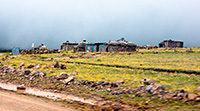
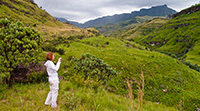
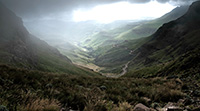
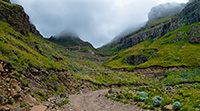
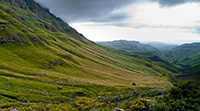
Comments
Marie
Vince